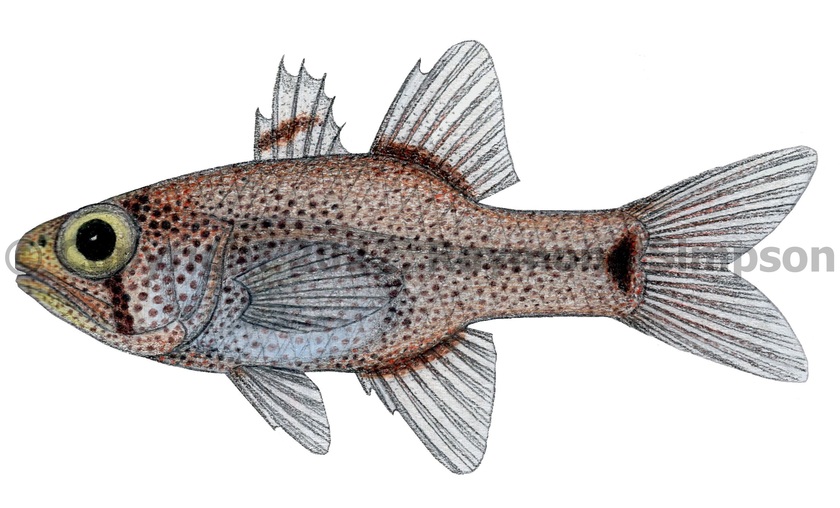
Common Name
Sponge Cardinalfish
Year Described
Böhlke & Randall, 1968
Identification
Dorsal Fin: VI, I-9
Anal Fin: II, 8
Pelvic Fin: I, 5
Pectoral Fin: 11
Gill Rakers: 12-15 lower (first arch)
Vertebrae: 10 precaudal, 14-15 caudal
A small fish with a fairly robust and moderately compressed body. Eye is large and the snout short. Mouth is fairly large and oblique, with the lower jaw slightly protruding. Jaws with bands of villiform teeth. Vomer and palatine with villiform teeth. Preopercular edge with a finely serrate margin. Preopercular flap extends close to opercular margin. There are two dorsal fins. The caudal fin is forked. Body scales ctenoid. There are 5-7 predorsal scales.
Color
Body translucent pale pinkish or pale orange-brown with pearly sheens. Melanophores on each scale form a network of dense spots over the whole body. Spots made up of minute melanophores. Stellate melanophores on the head. Snout yellowish. Base of caudal fin with a large oval blotch covering almost the entire peduncle. Base of dorsal and anal fins frequently with dark bases made up of tiny speckles (no pale gap). Rest of fins clear. Eye silvery to dark gray with a dark bar under it.
Size
Maximum size to 75mm TL.
Habitat
Found in shallow reefs, seagrass beds, and areas of shelly rubble.
Range
S. Florida to Suriname, including the Gulf of Mexico and the Caribbean. Also Bermuda.
References
Gon, O. 2002. Apogonidae (pp 1386-1391). In: Carpenter. 2002. The living marine resources of the Western Central Atlantic. Vol. 3: Bony fishes part 2 (Opistognathidae to Molidae), sea turtles and sea mammals. FAO Species Identification Guides for Fisheries Purposes. American Society of Ichthyologists and Herpetologists Special Publication No. 5.
McEachran, J.D. & J.D. Fechhelm. 2005. Fishes of the Gulf of Mexico. Volume 2: Scorpaeniformes to Tetraodontiformes. University of Texas Press, Austin. i-viii +1-1004.